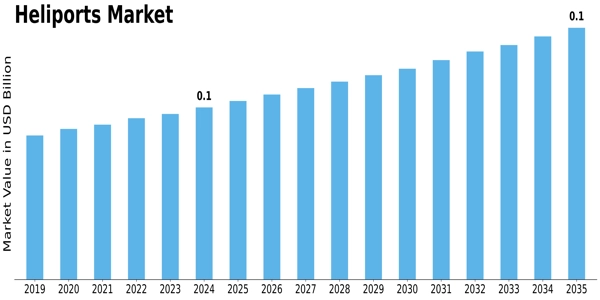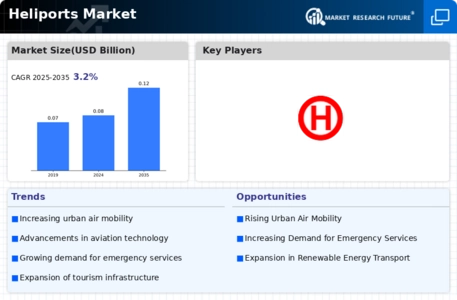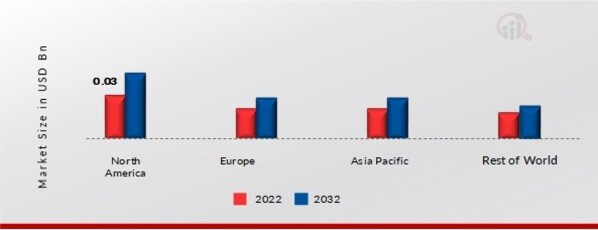Heliports Size
Heliports Market Growth Projections and Opportunities
The heliports market is influenced by various factors that shape its growth and development. One crucial factor is the increasing demand for efficient and flexible transportation solutions in urban and remote areas. Heliports provide a convenient and time-saving means of transportation, allowing passengers to bypass ground congestion and reach their destinations quickly. As urbanization continues to grow and cities become more congested, there is a growing need for heliports to support urban air mobility services, air taxi operations, emergency medical services, and corporate transportation needs. Additionally, in remote and inaccessible areas such as offshore platforms, mountainous regions, and island communities, heliports serve as vital transportation hubs, providing essential connectivity for industries such as oil and gas, tourism, and emergency response.
Moreover, technological advancements play a crucial role in shaping the heliports market. Advances in heliport infrastructure, helicopter design, navigation systems, and air traffic management technologies enhance safety, efficiency, and usability of heliports. Modern heliports are equipped with state-of-the-art lighting systems, navigation aids, and weather monitoring equipment to ensure safe and reliable operations in all weather conditions. Additionally, advancements in helicopter design, such as noise reduction technologies and increased fuel efficiency, improve the environmental performance and operational capabilities of helicopters, making them more suitable for heliport operations in urban and environmentally sensitive areas.
Furthermore, regulatory frameworks and safety standards significantly influence market dynamics in the heliports sector. Aviation authorities and regulatory agencies impose strict regulations and guidelines governing the design, construction, operation, and maintenance of heliports to ensure compliance with safety, security, and environmental requirements. Compliance with these regulations is essential to ensure the safety of passengers, crew, and ground personnel, as well as to minimize the risk of accidents, incidents, and environmental damage. Additionally, heliport operators must adhere to air traffic control procedures, airspace regulations, and noise abatement measures to mitigate the impact of helicopter operations on surrounding communities and airspace users.
Additionally, market demand for heliports is driven by factors such as economic growth, tourism trends, and infrastructure development. As economies grow and incomes rise, there is an increasing demand for luxury and executive transportation services, driving market demand for heliports catering to high-net-worth individuals, corporate clients, and VIP travelers. Moreover, as tourism continues to grow and travel preferences evolve, there is a growing demand for heliport facilities in popular tourist destinations, luxury resorts, and remote wilderness areas, providing tourists with unique and memorable transportation experiences. Additionally, infrastructure development initiatives, such as urban redevelopment projects, waterfront revitalization efforts, and transportation corridor upgrades, create opportunities for heliport development to support economic growth, job creation, and urban revitalization efforts.
Moreover, market factors such as environmental sustainability, community engagement, and public perception influence the development of heliports. As concerns about noise pollution, air quality, and environmental impact increase, heliport operators and developers must address environmental sustainability considerations in heliport design, operations, and mitigation measures. This includes adopting noise reduction technologies, implementing flight path optimization strategies, and engaging with local communities to address concerns and mitigate the impact of helicopter operations on the environment and quality of life. Additionally, public perception and acceptance of heliports play a crucial role in determining the success and viability of heliport projects, requiring proactive communication, stakeholder engagement, and community outreach efforts to build trust and support for heliport development initiatives.
Furthermore, the impact of emerging technologies, such as electric vertical takeoff and landing (eVTOL) aircraft and urban air mobility (UAM) solutions, is reshaping the heliports market. eVTOL aircraft offer promising alternatives to traditional helicopters, offering electric propulsion, autonomous flight capabilities, and vertical takeoff and landing capabilities, enabling quieter, cleaner, and more efficient urban air transportation. As eVTOL aircraft technology matures and regulatory frameworks evolve, there is a growing interest in developing vertiports and urban air mobility infrastructure to support the deployment of eVTOL aircraft and air taxi services in urban areas. Additionally, advancements in drone technology, air traffic management systems, and digitalization enable integration of unmanned aerial vehicles (UAVs) and autonomous drones into heliport operations, expanding the range of services and applications for heliports in various industries, such as logistics, emergency response, and aerial photography.






Leave a Comment